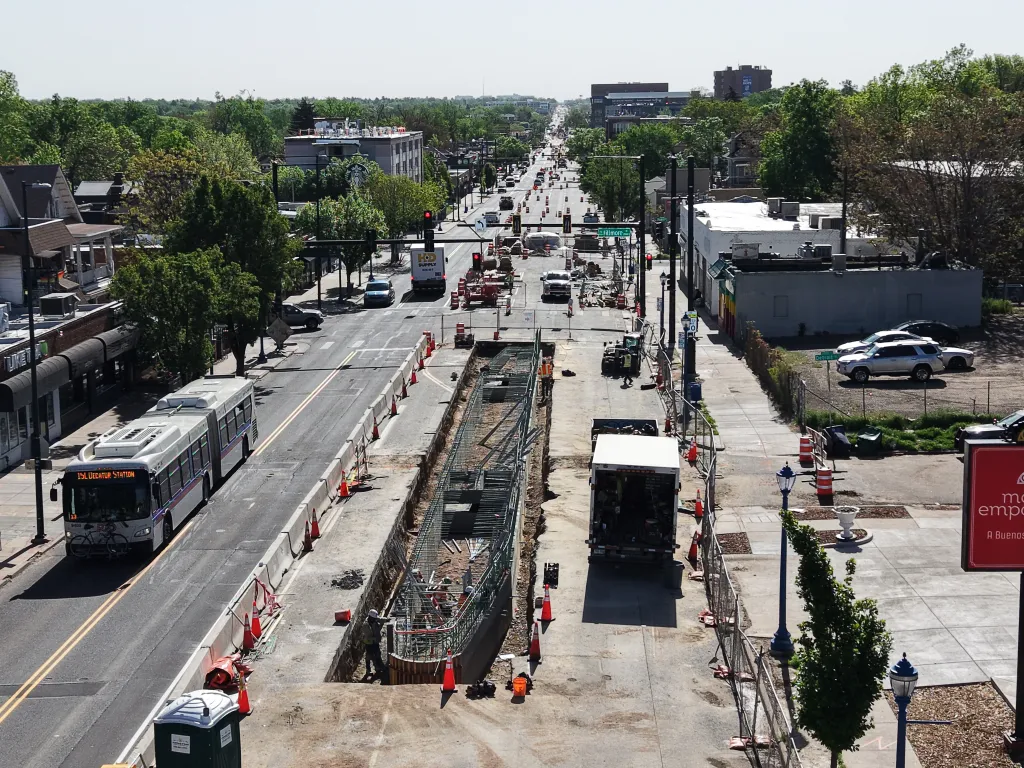
When Denver voters approved a major bond package on the 2017 ballot, the list of promised projects included a plan for pedestrian upgrades along East Colfax Avenue.
The Colfax Corridor Improvements project — originally allocated $20 million — was meant to add lighting, trees and better crosswalks in four major business districts across Colfax. But two years after voters approved the bond package, part of that project was under threat.
A significant portion of the Colfax Mayfair Business District, which had been included in the Elevate bond plan when it went before voters, suddenly wasn’t set to benefit from the bond. The city wanted to pool the dollars intended for the improvements with the much costlier plan to bring a bus rapid transit system to East Colfax, said Hilarie Portell, the executive director of the district, which is just west of Monaco Parkway.
“We said, ‘No, you can’t. Voters voted on two buckets,’ ” Portell said this month.
After Portell informed City Council members of the situation and they started applying pressure and demanding in-writing commitments, city officials said they would create a plan to get the Mayfair BID improvements done. Portell said city officials ultimately regained her trust after what was an initial “gut punch.”
In November, Denver voters will again consider allowing the city to take on major debt to tackle big projects — this time, nearly $1 billion. When ballots go out next month, they’ll summarize the types of projects set for funding in five measures, while a companion ordinance will list out the dozens of projects meant to benefit.
But the estimates used to produce those lists are ballpark figures that, if past bonds are a guide, tend to vary significantly once construction on a project begins. An executive committee for the bond is able to move dollars around within each purpose as needed. Sometimes, the scale of the projects can quietly change, too.
A Denver Post analysis of the project costs from the Elevate bond shows the city took advantage of the flexibility available in the execution of bond projects. A former city finance official pointed out that those decisions were often made behind closed doors.
“I would say to anybody who is advancing a project: Getting it on the list is only just the beginning,” Portell said, pointing to a need to stay engaged. “You really do have to continue to advocate for your project every step of the way.”
She added: “It’s not over until they’re built.”
Bonds are a common way for cities to take on dozens of major projects at the same time. If approved in November, the new ballot measures — a package called Vibrant Denver — would allow the city to sell $950 million in bonds and use the borrowed dollars to pay for nearly 60 capital improvement projects, some of which are for citywide work that would span several areas.
Nearly half of the bond value would go to transportation and mobility projects, with the rest paying for projects in four other categories: city facilities, parks and recreation, housing and shelter, and health and human services.
The city would pay back the bondholders over time through property taxes. The bond proposal wouldn’t raise taxes because it would replace existing debt that the city is paying off now. If voters reject the proposals, however, taxes could go toward paying down current bonds faster.
Tracking changes
One of the ways to track progress on bond projects is through the annual bond financial reports the city publishes each year. These show how much the city has budgeted for each project and how much it has been spent so far. A comparison of annual reports shows how the executive committee has changed the allotments.
The 16th Street mall, for instance, was initially set to receive $13 million in bond dollars under the 2017 ballot measure. In 2024, it was earmarked for $28 million, representing a 117% increase.
The project, once estimated to cost as little as $90 million, has actually cost more than $175 million after multiple delays put it behind schedule. The city has pulled funding from multiple sources for the project, which is set to be finished soon.
Improvements to the Broadway corridor from Colfax to I-25, including new protected bike lanes for much of that stretch and a dedicated bus lane, were originally estimated to cost $12 million in 2017. By the time the work was completed in 2024, the project received only $6.3 million from the bond.
City officials supplemented that budget with state grants, ultimately spending about $14 million on the improvements. That’s a tactic city financers used on several other bond projects as well, said Molly Scarbrough, a deputy program manager for the Denver GO Bond Program, which abbreviates general obligation bond.
“The original project budgets were based on cost estimates using the best available information at the time (the) council referred the bond to the ballot,” Scarbrough wrote in an email. “Cost estimates are refined over time as a project progresses through its lifecycle from development to design to construction and more information is known about the project and construction environment.”
Many estimates changed significantly as the COVID-19 pandemic and its fallout caused sharp inflation, Scarborough said.
The annual financial reports don’t show if city officials changed the scope of the projects, as was attempted in the case of the Colfax corridor improvements. But Denver Mayor Mike Johnston, who entered office in 2023, told The Post that the city had altered some Elevate projects.
“There were definitely changes,” he said when asked about the scope of that program’s projects.
He said such changes were part of the struggle with estimating costs for projects that could be completed over a 10-year period, as was intended in the Elevate program. His bond proposal will be for projects that must be finished in six years.
In response to questions from The Post about projects changing scope, a spokesperson for the city’s Elevate program said there were only three cases of that happening.
The Swansea Recreation Center in northeast Denver and the indoor pool at the Green Valley Ranch Recreation Center both included specific square footage expectations in their original scope that didn’t get fully implemented, though the intents of the projects were still fulfilled, said Nick Marion, a spokesperson for the Department of Finance.
The West 13th Avenue Multimodal Reconstruction project also changed to include a different design than originally intended.
It’s difficult to track how any other projects’ changed. While the city has a dashboard showing levels of completion on each bond project, it doesn’t include a description of what specific action the project initially promised — and whether there are any differences in what construction crews actually built.
The Green Valley Ranch Pool, for instance, is marked as “complete” on the dashboard, with no indication that the scope changed somewhat.
The dashboard shows that nearly 80% of the Elevate projects are complete. The remaining 93 projects will have to be completed by 2027.
Questioning bond estimates
Decisions around bond projects largely end up happening behind closed doors, said Earl Jackson, who was the chief financial officer for the Department of Transportation and Infrastructure until he volunteered to be laid off last month.
“If I had to put a pulse on it, I’d say 50% of it was a black box,” he said.
Jackson said city officials held a “lessons learned” workshop looking closer at earlier bond projects and that one of the main takeaways was that project managers needed more time to prepare their estimates so they were more accurate.
He said that didn’t happen when developing the Vibrant Bond proposal, which was developed over the course of several months this year.
“There’s no way that those cost estimates are going to be anywhere near where they need to be because of how rushed the process was in terms of creating those projects and scoping,” he said.
With a precarious global economy, ongoing tariff battles and the city’s own budget shortfall, it’s difficult to say how the projects described in the Vibrant Bond will be executed, Jackson said.
“It’s going to be very difficult to bring those things to life with the resources the department has,” he said. “There’s so much uncertainty.”
Marion said while some specific design elements may change, there are very few examples of a bond project’s scope actually coming up short.
“Our goal within bond programs is always to deliver projects as envisioned by community, on time and within budget, that both repair and improve infrastructure across the city,” he said.



